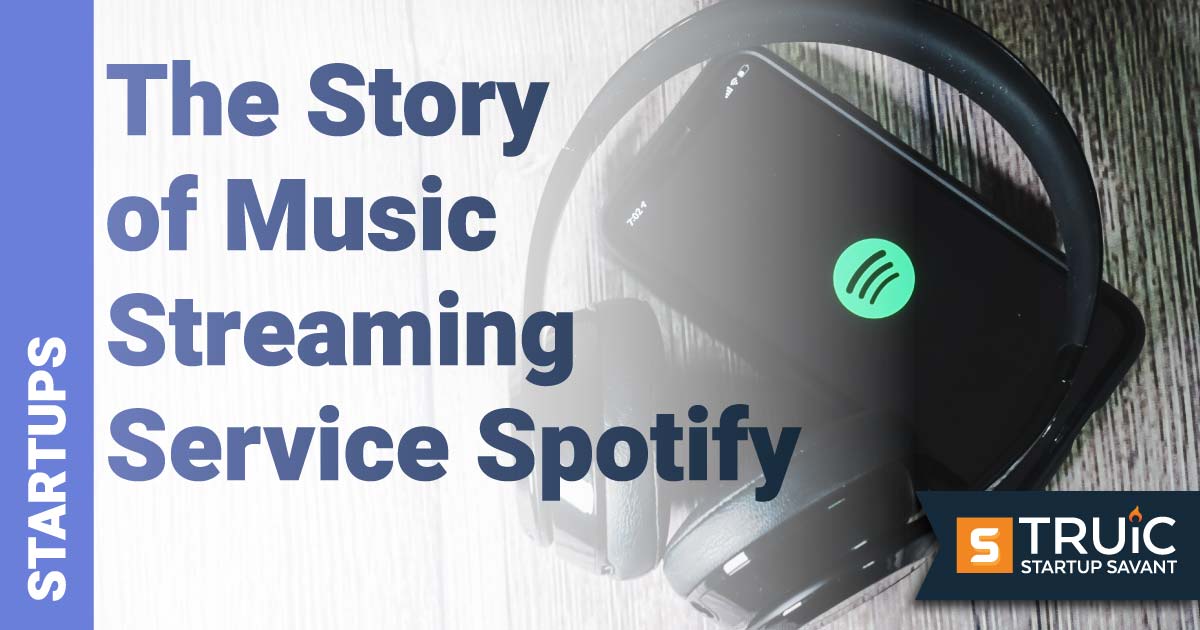Revolutionizing the Music Industry: How Spotify Helped Take Streaming Mainstream

Last Updated: By Madison Holt
For most people, Spotify needs no introduction, as it’s one of the most popular ways to stream music, podcasts, and other audio content. However, Spotify considers itself more than just another streaming service; its mission is nothing less than to “unlock the potential of human creativity—by giving a million creative artists the opportunity to live off their art and billions of fans the opportunity to enjoy and be inspired by it.”
Whether the company lives up to that mission is in the eye of the beholder. However, there’s no denying that other companies can learn from its history, business model, and marketing strategies. For more on all of this, keep reading.
Spotify Overview and History
Daniel Ek, the former CTO of Stardoll, and Martin Lorentzon, co-founder of Tradedoubler, founded Spotify in Sweden in 2006. The company started its ad-supported free service tier in the U.K. in 2010.
The free service was launched in the US in 2011. US subscribers could listen to an unlimited amount of music for free for six months, after which the free tier was capped at 10 hours of streaming per month. These limits were later removed, and now users can now listen to the ad-supported free version as much as they want.
Spotify expanded its U.S. headquarters in New York City in February 2017, hiring about 1,000 new employees on top of the 832 existing ones. The company went public in April 2018.
Here are some other notable milestones.
Adding New Users, Setting Streaming Records
Spotify’s subscriber base has grown quickly. The company hit the 1 million subscriber mark in Europe in March 2011 and doubled that in just a few short months by September of the same year. It reached 15 million active users globally by August 2012 and 20 million by December 2012 (five million of which were paying customers).
The numbers continued to climb: 24 million by March 2013, 60 million by December 2014, 75 million by June 2015, 100 million by June 2016, etc. Today, Spotify claims to be the world’s most popular audio streaming subscription service, with some 515 million users. It has about 210 million paid subscribers in more than 180 markets, including Europe, Africa, the Americas, Asia, and Oceania.
Meanwhile, popular artists have been setting streaming records on Spotify as its user base has grown. For example, on October 15, “Thinking Out Loud” by Ed Sheeran became the first song to pass 500 million streams. Artists like Rihanna, Justin Bieber, Drake, and Taylor Swift have been among the most successful artists on the platform.
Making Deals
Spotify has made a number of acquisitions over the years to help solidify its dominant position in the streaming industry and enhance its services. Some highlights include:
- Tunigo, a music discovery app
- The Echo Nest, a music intelligence service
- Seed Scientific, a data science consulting firm that helps develop advanced analytics
- Sonalytic, a company that helps improved personalized playlists
- The music licensing platform Loudr
- Various music podcast networks and the exclusive rights to stream certain podcasts
- Podz, a podcast discovery startup
- The podcast advertising companies Chartable and Podsights
Spotify’s Business Model
Like a lot of other music streaming services, Spotify has a “freemium” business model. You can stream music for free, but there are significant limitations. For example, users of the free service have to put up with ads. They also can’t access certain features, such as the ability to skip songs, play a good portion of Spotify’s catalog, and download songs and podcasts to a mobile device for playing offline.
Because of these limitations, some users eventually move to a paid Spotify subscription. These range from $9.99 a month for an individual to $15.99 a month for a family of up to six. According to Four Week MBA, of the approximately $12.9 billion in revenue that the company generated in 2022, about 87 percent came from paid subscriptions. The rest came from selling ads.
Four Week MBA says that in 2022, Spotify’s premium users generated almost seven times as much revenue as free users. That said, like most “freemium” services, Spotif’s free service introduces the brand to more people and helps funnel users to the premium service.
Customer Base
Business Model Analyst notes that Spotify has three basic types of customers:
- Users: This is the largest segment, consisting of people who listen to music, podcasts, and other content on the service.
- Content Creators: Someone has to create all of that content, of course. In Spotify’s case, those people include musicians, record labels, and podcasters.
- Advertisers: As mentioned, Spotify sells ads that are displayed on its free service.
Statista reports that young professionals ages 25-34 comprise the largest group of Spotify users. This group is followed by those ages 18-24. According to Startup Talky, the average Spotify user spends a lot of time on the platform — about 118 minutes a day.
Value Proposition
Each of the customer segments above benefits from Spotify in different ways:
Users get legal access to millions of songs and podcasts whenever they want to listen, without having to worry about piracy or copyright issues. Plus, Spotify offers better sound quality than some other music streaming services (although most of them have caught up in this respect). Users also can personalize their experience on the platform by creating playlists or discovering new content through Spotify’s algorithm-driven recommendations, which are based in part on listening history.
Content creators use Spotify first and foremost because they can reach millions of people through the platform. They also can earn royalties whenever their content is played, and they can see usage statistics to help determine which content is most popular with various audiences.
Advertisers like Spotify for some of the same reasons that content creators do, especially for the huge audience they can access. They also can target ads to various types of users based on factors like listening habits and demographics. Spotify even offers free tools to help create ads and track their performance.
Spotify’s Marketing Strategies
Spotify employs several marketing strategies to grow its user base.
Leveraging User Data
A big part of what Spotify does is market content – music and podcasts, primarily – to as many people as possible. That means the service can’t just stick with the popular artists that everyone knows about. While mainstream artists are obviously important, it’s also vital that Spotify identify and market new artists that appeal to more niche audiences. Regularly discovering and promoting new artists helps the service reach users who may not otherwise listen.
Startup Talky explains that one of the primary ways the platform does this is to leverage the copious amounts of data it collects on users’ listening tastes. It uses this data to find new artists. For example, if a given customer likes a particular new artist, chances are that other customers in the same demographic group and/or with the same general listening habits will, too.
Making Strategic Deals
On top of discovering lots of new artists, Spotify has inked deals with popular established ones like Joe Rogan, Robert Downey Jr, Mike Tyson, and Elon Musk. It also has exclusive deals with major music labels. This has allowed the company to market itself as the only way to hear exclusive content from these individuals.
Buildd.co notes that Spotify has also made a number of acquisitions that have improved its competitiveness. These include Gimlet Media and Anchor FM, which have allowed Spotify to make inroads into the podcast market.
The company has also partnered with music festivals, concert tours, and other live events, Build.co says. This has allowed it to expand its audience even further among particularly enthusiastic users.
Emphasizing Personalization, User-Friendliness
Closely related to leveraging user data is personalizing the Spotify experience for each user, Startup Talky notes. Like a lot of other streaming services, this is accomplished through algorithms that “learn” what types of music, podcasts, and other content a given user likes and then recommends similar content the user may not have heard of.
In Spotify’s case, personalization not only helps users directly but it helps artists gain exposure to new audiences. This creates a virtuous circle that benefits Spotify, users, and artists alike.
In addition, most users find that Spotify’s platform is generally user-friendly, with an interface that’s easy to navigate and uses simple graphics. This provides a seamless listening experience no matter if you’re using Spotify on a desktop computer, cell phone, or tablet. It also makes the platform attractive to musicians and podcasters because they know their content will be easy to find and enjoy.
Using Emotional Ads
Startup Talky says that Spotify has perfected the art of using emotional ads to help it stand out from competitors like Apple and Amazon that offer similar content. For example, in 2013, Spotify released an ad that emphasized how much emotional power music can have over us.
Along the same lines, in 2014 Spotify introduced a campaign called #thatsongwhen, in which its users could discuss their favorite songs and the emotions those songs instilled in them. The company launched other emotion-driven campaigns in 2021 and 2022 called #Onlyyou and #Spotifywrapped.
What’s Next For Spotify
At Spotify’s Stream On 2023 event in March, it announced several new features that are launching this year. As reported by RouteNote and Bustle, these include:
- Showcase: A promotional tool that can help boost a creator’s content.
- Discovery Mode: A feature to help music labels, distributors, and eventually artists boost certain songs in Spotify’s algorithm, which in turn encourages more user engagement, such as likes and follows.
- Home feed and search updates: Improvements that, for example, allow users to preview content before saving them to their library and discover new music by sampling short song clips in search results.
Also at Stream On 2023, the company announced changes aimed at helping podcasters, including an effort to combine various podcasting tools into Spotify to make creating content easier.
According to The RouteNote Blog, Sulinna Ong, Spotify’s global head of editorial, said that Spotify will continue to provide “artists more options to build their careers, whether they’re on major labels, indie labels, or independently distributed.”
Ong added that “Of these 57,000 artists [earning +$10k on Spotify], over 20,000 live outside the top 10 music markets and a quarter of them self-release their music through an independent distributor. Artists who in the past might have struggled to find opportunities, are now finding their audiences and making a living. Our global reach, combined with our programming is creating space for all new types of artists to find an audience and turn them into fans.”
Tell Us Your Startup Story
Are you a startup founder and want to share your entrepreneurial journey with our readers? Click below to contact us today!


